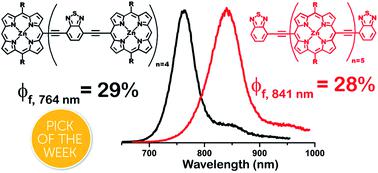当前位置:
X-MOL 学术
›
Chem. Sci.
›
论文详情
Our official English website, www.x-mol.net, welcomes your feedback! (Note: you will need to create a separate account there.)
Driving high quantum yield NIR emission through proquinoidal linkage motifs in conjugated supermolecular arrays
Chemical Science ( IF 8.4 ) Pub Date : 2020-08-05 , DOI: 10.1039/d0sc03446k Erin J. Viere 1, 2, 3, 4, 5 , Wei Qi 1, 2, 3, 4, 5 , Ian N. Stanton 1, 2, 3, 4, 5 , Peng Zhang 1, 2, 3, 4, 5 , Michael J. Therien 1, 2, 3, 4, 5
Chemical Science ( IF 8.4 ) Pub Date : 2020-08-05 , DOI: 10.1039/d0sc03446k Erin J. Viere 1, 2, 3, 4, 5 , Wei Qi 1, 2, 3, 4, 5 , Ian N. Stanton 1, 2, 3, 4, 5 , Peng Zhang 1, 2, 3, 4, 5 , Michael J. Therien 1, 2, 3, 4, 5
Affiliation

|
High quantum yield NIR fluorophores are rare. Factors that drive low emission quantum yields at long wavelength include the facts that radiative rate constants increase proportional to the cube of the emission energy, while nonradiative rate constants increase in an approximately exponentially with decreasing S0–S1 energy gaps (in accordance with the energy gap law). This work demonstrates how the proquinoidal BTD building blocks can be utilized to minimize the extent of excited-state structural relaxation relative to the ground-state conformation in highly conjugated porphyrin oligomers, and shows that 4-ethynylbenzo[c][1,2,5]thiadiazole (E-BTD) units that terminate meso-to-meso ethyne-bridged (porphinato)zinc (PZnn) arrays, and 4,7-diethynylbenzo[c][1,2,5]thiadiazole (E-BTD-E) spacers that are integrated into the backbone of these compositions, elucidate new classes of impressive NIR fluorophores. We report the syntheses, electronic structural properties, and emissive characteristics of neoteric PZn-(BTD-PZn)n, PZn2-(BTD-PZn2)n, and BTD-PZnn-BTD fluorophores. Absolute fluorescence quantum yield (ϕf) measurements, acquired using a calibrated integrating-sphere-based measurement system, demonstrate that these supermolecules display extraordinary ϕf values that range from 10–25% in THF solvent, and between 28–36% in toluene solvent over the 700–900 nm window of the NIR. These studies underscore how the regulation of proquinoidal conjugation motifs can be exploited to drive excited-state dynamical properties important for high quantum yield long-wavelength fluorescence emission.
中文翻译:

通过共轭超分子阵列中的proquinoidal链接基元驱动高量子产率的NIR发射
高量子产率的近红外荧光团是罕见的。导致长波长发射量子产率低的因素包括以下事实:辐射速率常数与发射能量的立方成正比,而非辐射速率常数则随着S 0 –S 1能隙的减小而呈指数增长。能隙定律)。这项工作证明了在高共轭卟啉低聚物中,如何利用原醌基BTD构建基块使相对于基态构象的激发态结构弛豫程度最小化,并表明4-乙炔基苯并[ c ] [1,2,5 ]噻二唑(E-BTD)单元终止内消旋-到-内消旋乙炔桥接(卟啉)锌(PZn n)阵列,和集成到这些组合物骨架中的4,7-二乙炔基苯[ c ] [1,2,5]噻二唑(E-BTD-E)间隔基,阐明了新的一类令人印象深刻的NIR荧光团。我们报告了新型PZn-(BTD-PZn)n,PZn 2-(BTD-PZn 2)n和BTD-PZn n -BTD荧光团的合成,电子结构性质和发射特性。绝对荧光量子产率(ϕ f)测量值,是使用经过校准的积分球测量系统所获得的,表明这些超分子在700-900 nm范围内表现出非常出色的ϕ f值,其在THF溶剂中的范围为10–25%,在甲苯溶剂中的范围为28–36%。 NIR的窗口。这些研究强调了如何利用原醌类共轭基序的调控来驱动激发态动力学特性,这对于高量子产率长波长荧光发射很重要。
更新日期:2020-08-12
中文翻译:

通过共轭超分子阵列中的proquinoidal链接基元驱动高量子产率的NIR发射
高量子产率的近红外荧光团是罕见的。导致长波长发射量子产率低的因素包括以下事实:辐射速率常数与发射能量的立方成正比,而非辐射速率常数则随着S 0 –S 1能隙的减小而呈指数增长。能隙定律)。这项工作证明了在高共轭卟啉低聚物中,如何利用原醌基BTD构建基块使相对于基态构象的激发态结构弛豫程度最小化,并表明4-乙炔基苯并[ c ] [1,2,5 ]噻二唑(E-BTD)单元终止内消旋-到-内消旋乙炔桥接(卟啉)锌(PZn n)阵列,和集成到这些组合物骨架中的4,7-二乙炔基苯[ c ] [1,2,5]噻二唑(E-BTD-E)间隔基,阐明了新的一类令人印象深刻的NIR荧光团。我们报告了新型PZn-(BTD-PZn)n,PZn 2-(BTD-PZn 2)n和BTD-PZn n -BTD荧光团的合成,电子结构性质和发射特性。绝对荧光量子产率(ϕ f)测量值,是使用经过校准的积分球测量系统所获得的,表明这些超分子在700-900 nm范围内表现出非常出色的ϕ f值,其在THF溶剂中的范围为10–25%,在甲苯溶剂中的范围为28–36%。 NIR的窗口。这些研究强调了如何利用原醌类共轭基序的调控来驱动激发态动力学特性,这对于高量子产率长波长荧光发射很重要。


























 京公网安备 11010802027423号
京公网安备 11010802027423号